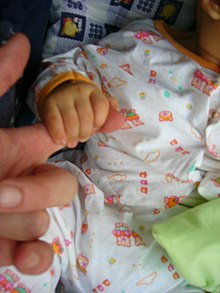
Reflex
In biology, a reflex, or reflex action, is an involuntary, unplanned sequence or action and nearly instantaneous response to a stimulus.
Reflexes are found with varying levels of complexity in organisms with a nervous system. A reflex occurs via neural pathways in the nervous system called reflex arcs. A stimulus initiates a neural signal, which is carried to a synapse. The signal is then transferred across the synapse to a motor neuron, which evokes a target response. These neural signals do not always travel to the brain, so many reflexes are an automatic response to a stimulus that does not receive or need conscious thought.
Many reflexes are fine-tuned to increase organism survival and self-defense. This is observed in reflexes such as the startle reflex, which provides an automatic response to an unexpected stimulus, and the feline righting reflex, which reorients a cat's body when falling to ensure safe landing. The simplest type of reflex, a short-latency reflex, has a single synapse, or junction, in the signaling pathway. Long-latency reflexes produce nerve signals that are transduced across multiple synapses before generating the reflex response.
Types of human reflexes
Myotatic reflexes
The myotatic or muscle stretch reflexes (sometimes known as deep tendon reflexes) provide information on the integrity of the central nervous system and peripheral nervous system. This information can be detected using electromyography (EMG). Generally, decreased reflexes indicate a peripheral problem, and lively or exaggerated reflexes a central one. A stretch reflex is the contraction of a muscle in response to its lengthwise stretch.
- Biceps reflex (C5, C6)
- Brachioradialis reflex (C5, C6, C7)
- Extensor digitorum reflex (C6, C7)
- Triceps reflex (C6, C7, C8)
- Patellar reflex or knee-jerk reflex (L2, L3, L4)
- Ankle jerk reflex (Achilles reflex) (S1, S2)
While the reflexes above are stimulated mechanically, the term H-reflex refers to the analogous reflex stimulated electrically, and tonic vibration reflex for those stimulated to vibration.
Tendon reflex
A tendon reflex is the contraction of a muscle in response to striking its tendon. The Golgi tendon reflex is the inverse of a stretch reflex.
Reflexes involving cranial nerves
| Name | Sensory | Motor |
| Pupillary light reflex | II | III |
| Accommodation reflex | II | III |
| Jaw jerk reflex | V | V |
| Corneal reflex, also known as the blink reflex | V | VII |
| Glabellar reflex | V | VII |
| Vestibulo-ocular reflex | VIII | III, IV, VI + |
| Gag reflex | IX | X |
Reflexes usually only observed in human infants
Newborn babies have a number of other reflexes which are not seen in adults, referred to as primitive reflexes. These automatic reactions to stimuli enable infants to respond to the environment before any learning has taken place. They include:
- Asymmetrical tonic neck reflex
- Palmomental reflex
- Moro reflex, also known as the startle reflex
- Palmar grasp reflex
- Rooting reflex
- Sucking reflex
- Symmetrical tonic neck reflex
- Tonic labyrinthine reflex
Other kinds of reflexes
Other reflexes found in the central nervous system include:
- Abdominal reflexes (T6-L1)
- Gastrocolic reflex
- Anocutaneous reflex (S2-S4)
- Baroreflex
- Cough reflex
- Cremasteric reflex (L1-L2)
- Diving reflex
- Lazarus sign
- Muscular defense
- Photic sneeze reflex
- Scratch reflex
- Sneeze
- Startle reflex
- Withdrawal reflex
Many of these reflexes are quite complex, requiring a number of synapses in a number of different nuclei in the central nervous system (e.g., the escape reflex). Others of these involve just a couple of synapses to function (e.g., the withdrawal reflex). Processes such as breathing, digestion, and the maintenance of the heartbeat can also be regarded as reflex actions, according to some definitions of the term.
Grading
In medicine, reflexes are often used to assess the health of the nervous system. Doctors will typically grade the activity of a reflex on a scale from 0 to 4. While 2+ is considered normal, some healthy individuals are hypo-reflexive and register all reflexes at 1+, while others are hyper-reflexive and register all reflexes at 3+.
| Grade | Description |
| 0 | Absent ("mute") |
| 1+ or + | Hypoactive |
| 2+ or ++ | "Normal" |
| 3+ or +++ | Hyperactive without clonus, with spread to adjacent muscle groups |
| 4+ or ++++ | Hyperactive with clonus |
Reflex modulation
Some might imagine that reflexes are immutable. In reality, however, most reflexes are flexible and can be substantially modified to match the requirements of the behavior in both vertebrates and invertebrates.
A good example of reflex modulation is the stretch reflex. When a muscle is stretched at rest, the stretch reflex leads to contraction of the muscle, thereby opposing stretch (resistance reflex). This helps to stabilize posture. During voluntary movements, however, the intensity (gain) of the reflex is reduced or its sign is even reversed. This prevents resistance reflexes from impeding movements.
The underlying sites and mechanisms of reflex modulation are not fully understood. There is evidence that the output of sensory neurons is directly modulated during behavior—for example, through presynaptic inhibition. The effect of sensory input upon motor neurons is also influenced by interneurons in the spinal cord or ventral nerve cord and by descending signals from the brain.
Other reflexes
Breathing can also be considered both involuntary and voluntary, since breath can be held through internal intercostal muscles.
See also
- All-or-none law
- Automatic behavior
- Conditioned reflex
- Instinct
- Jumping Frenchmen of Maine
- List of reflexes
- Preflexes
- Voluntary action
|
Physiology of the nervous system
| |||||||||
|---|---|---|---|---|---|---|---|---|---|
| Primarily CNS | |||||||||
| Primarily PNS | |||||||||
| Both |
|
||||||||
| Cranial nerve | |
|---|---|
| Stretch reflexes | |
| Primitive reflexes | |
| Superficial reflexes | |
| Cardiovascular | |
| Other | |
| Authority control: National |
|---|


